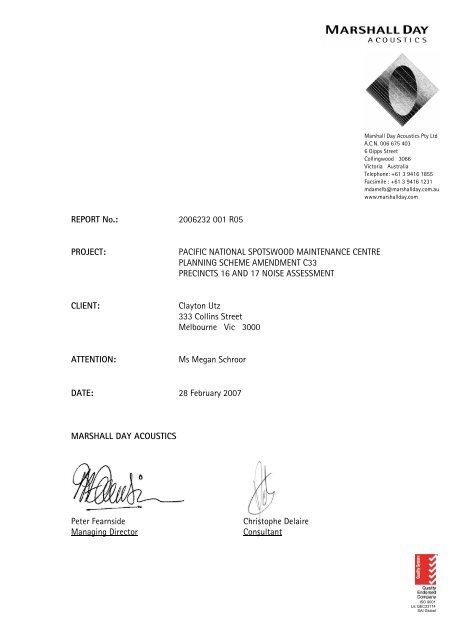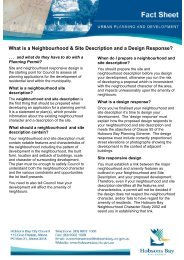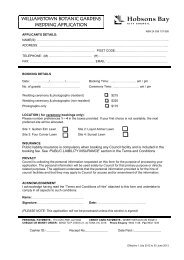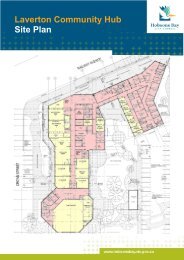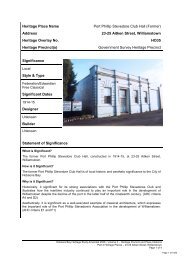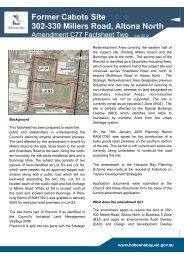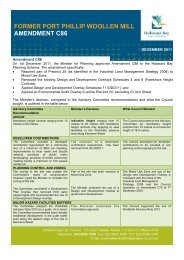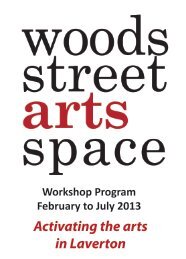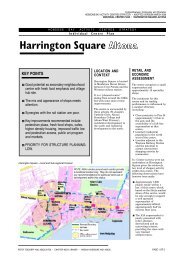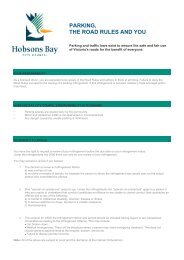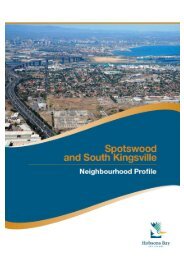PACIFIC NATIONAL SPOTSWOOD MAINTENANCE ... - Hobsons Bay
PACIFIC NATIONAL SPOTSWOOD MAINTENANCE ... - Hobsons Bay
PACIFIC NATIONAL SPOTSWOOD MAINTENANCE ... - Hobsons Bay
Create successful ePaper yourself
Turn your PDF publications into a flip-book with our unique Google optimized e-Paper software.
Marshall Day Acoustics Pty Ltd<br />
A.C.N. 006 675 403<br />
6 Gipps Street<br />
Collingwood 3066<br />
Victoria Australia<br />
Telephone: +61 3 9416 1855<br />
Facsimile : +61 3 9416 1231<br />
mdamelb@marshallday.com.au<br />
www.marshallday.com<br />
REPORT No.:<br />
2006232 001 R05<br />
PROJECT:<br />
<strong>PACIFIC</strong> <strong>NATIONAL</strong> <strong>SPOTSWOOD</strong> <strong>MAINTENANCE</strong> CENTRE<br />
PLANNING SCHEME AMENDMENT C33<br />
PRECINCTS 16 AND 17 NOISE ASSESSMENT<br />
CLIENT:<br />
Clayton Utz<br />
333 Collins Street<br />
Melbourne Vic 3000<br />
ATTENTION:<br />
Ms Megan Schroor<br />
DATE: 28 February 2007<br />
MARSHALL DAY ACOUSTICS<br />
Peter Fearnside<br />
Managing Director<br />
Christophe Delaire<br />
Consultant<br />
ISO 9001<br />
Lic QEC23174<br />
SAI Global
TABLE OF CONTENTS<br />
Page No.<br />
1.0 INTRODUCTION ....................................................................................................................................................................1<br />
2.0 SITE DESCRIPTION...............................................................................................................................................................1<br />
2.1 Site location<br />
2.2 Site operations<br />
2.3 Planning scheme zoning<br />
2.4 Planning Amendment C33<br />
3.0 NOISE CONSIDERATIONS ..................................................................................................................................................3<br />
4.0 NOISE ASSESSMENT CRITERIA ........................................................................................................................................4<br />
4.1 SEPP N-1<br />
4.2 Sleep disturbance<br />
5.0 NOISE MEASUREMENTS....................................................................................................................................................5<br />
5.1 Background noise levels<br />
5.2 SMC noise emissions<br />
6.0 NOISE ASSESSMENT...........................................................................................................................................................7<br />
6.1 Precinct 16 - Current conditions<br />
6.2 Precinct 16 - Future conditions<br />
6.3 Precinct 17<br />
7.0 NOISE CONTROL OPTIONS ................................................................................................................................................12<br />
7.1 SEPP N-1 – Precinct 16<br />
7.2 SEPP N-1 – Precinct 17<br />
7.3 Sleep disturbance<br />
8.0 CONCLUSIONS......................................................................................................................................................................14<br />
APPENDIX A<br />
APPENDIX B<br />
APPENDIX C<br />
APPENDIX D<br />
APPENDIX E<br />
ACOUSTIC TERMINOLOGY<br />
SITE AERIAL PHOTOGRAPH<br />
SMC OPERATIONS PROVIDED BY <strong>PACIFIC</strong> <strong>NATIONAL</strong><br />
PRECINCT 16 - NOISE CONTOURS<br />
PRECINCT 17 - NOISE CONTOURS
1.0 INTRODUCTION<br />
The Pacific National Spotswood Maintenance Centre (SMC) operates from<br />
561-569 Melbourne Road, Spotswood. The facility provides engineering maintenance<br />
services to Pacific National 24 hours per day, 365 days per year.<br />
Marshall Day Acoustics Pty Ltd has been commissioned by Clayton Utz, on behalf of<br />
Pacific National, to provide an assessment of the acoustic implications of the proposed<br />
Planning Scheme Amendment C33 on the SMC operations at Spotswood.<br />
As part of the Planning Scheme Amendment C33, it is proposed to incorporate the<br />
<strong>Hobsons</strong> <strong>Bay</strong> Industrial Land Management Strategy dated 2006 into the Planning<br />
Scheme. This would provide a strategic basis to rezone an adjacent parcel of land to<br />
the south of the existing rail line known as Precinct 16, currently zoned Industrial Use<br />
3 (IN3Z), to Residential 1 Use (R1Z). This triangular shaped parcel of land is generally<br />
bounded by Stephenson Street to the west and Blackshaws Road to the south.<br />
The Planning Scheme Amendment C33 also identifies an adjacent parcel of land to the<br />
north-east of the SMC site known as part Precinct 17 as a strategic redevelopment<br />
site, which could potentially be used for residential development. This triangular<br />
shaped parcel of land is bounded by Birmingham Street to the north, Melbourne Road<br />
to the east and the SMC site to the south.<br />
Any future residential development within Precincts 16 and 17 may affect operations<br />
at the SMC site by constraining allowable noise emissions.<br />
Acoustic terminology used throughout this report is detailed in Appendix A.<br />
2.0 SITE DESCRIPTION<br />
2.1 Site location<br />
The SMC site is located at 561-569 Melbourne Road, Spotswood and is bounded by the<br />
following:<br />
• Residential properties across Birmingham Street to the north<br />
• Residential properties across Birmingham Street beyond disused land (Precinct 17)<br />
to the north-east<br />
• Melbourne Road to the east<br />
• Residential properties along Blackshaws Road across the railway line and beyond<br />
disused land (Precinct 16) to the south<br />
• Industrial properties to the west.<br />
S:\Project\2006\2006232ML\RP 001 R05 0228 - SMC noise impact assessment - FINAL.doc 1
2.2 Site operations<br />
The SMC is a facility of national significance that maintains all 120 premium NR Class<br />
locomotives in Australia, with one locomotive scheduled for service daily in addition to<br />
breakdowns and repairs to NR locomotives. Works occur on site 24 hours a day, 7 days<br />
a week and 365 days per year.<br />
Locomotives arriving at the site enter from the north-western corner directly from the<br />
freight train line. The locomotives stand at the north-western corner of the site and<br />
wait for a systematic changeover to occur. It is common for a second locomotive to be<br />
waiting, idling on the exit line adjacent to the railway line, after its routine service<br />
and/or repair, washing and testing has been completed.<br />
The SMC employs staff on 12 hour shifts from 0800-2000hrs (8:00am-8:00pm) and<br />
2000-0800hrs (8:00pm-8:00am).<br />
The site consists of three buildings as follows:<br />
• The main building located to the east of the site includes the Main Workshop, the<br />
boiler room and administration offices. The Main Workshop can accommodate up<br />
to 6 locomotives at any one time<br />
• The shed located to the north of the site is the Wash Facility where locomotives are<br />
cleaned after maintenance<br />
• The shed located to the west of the site is the Load Test Cell. The locomotives are<br />
tested in this shed before and after maintenance.<br />
Occasionally, locomotives are also tested outside the Load Test Cell, usually to the<br />
south of the Wash Facility and/or to the south and west of the Main Workshop.<br />
However, it is our understanding that these outdoor tests do not occur after 2000hrs<br />
(8:00pm).<br />
An aerial photograph of the site is provided in Appendix B.<br />
2.3 Planning scheme zoning<br />
The SMC site, including the vehicle access way, is zoned Industrial 1 (IN1Z).<br />
The vacant land to the north is presently zoned Mixed Use (MUZ) and beyond this,<br />
from the north side of Birmingham Street extending as far as the northern municipal<br />
boundary at the Westgate Freeway, the land is included in a Residential 1 Zone (R1Z).<br />
The railway land abutting the south-western boundary of the site is zoned Public Use 4<br />
(Transport). Land immediately abutting the railway land to the southern side of the site<br />
on either side of Sutton Street extending west to Stephenson Street is zoned Industrial<br />
3 (IN3Z) except for a small pocket of Residential 1 zoned land that abuts the northern<br />
side of Blackshaws Road and the southern end of the east side of Stephenson Street.<br />
S:\Project\2006\2006232ML\RP 001 R05 0228 - SMC noise impact assessment - FINAL.doc 2
Figure 1: Zoning surrounding the SMC site<br />
2.4 Planning Amendment C33<br />
Precinct 16 is a large site that is included in an Industrial 3 Zone located to the south<br />
west of the SMC site, separated only by the heavily used east/west freight rail line.<br />
Part of the land, known as the former Caltex site, is currently undergoing<br />
rehabilitation.<br />
The Planning Scheme Amendment C33 proposes the incorporation of the Council<br />
revised Industrial Land Management Strategy dated 2006 which seeks to provide a<br />
strategic basis for rezoning Precinct 16 (identified as a Strategic Development Area)<br />
from an Industrial 3 Zone to a Residential 1 Zone.<br />
Pursuant to the revised Hobson’s <strong>Bay</strong> Industrial Land Management Strategy dated<br />
October 2006, that part of Precinct 17 which is currently included in a mixed Use Zone<br />
is to maintain its current zoning. However, any viable use of the site is to recognise<br />
and support the ongoing use of the SMC and provide for noise buffers and attenuation<br />
measures.<br />
3.0 NOISE CONSIDERATIONS<br />
Noise emissions from the SMC facility are governed by permissible noise limits set<br />
under State Environment Protection Policy (Control of Noise from Commerce, Industry<br />
and Trade) No. N-1 (SEPP N-1). Compliance with SEPP N-1 is mandatory in the State<br />
of Victoria.<br />
S:\Project\2006\2006232ML\RP 001 R05 0228 - SMC noise impact assessment - FINAL.doc 3
The potential development of residential properties closer to or even adjacent to the<br />
SMC site introduces a new noise-sensitive area and the SMC will be obliged to meet<br />
the noise limits set by SEPP N-1 at these new properties. Currently, the restrictions<br />
placed on the maintenance facility are minor and do not restrict the operations of the<br />
facility.<br />
If any residential development were to proceed, it is possible that the noise emissions<br />
from the SMC site may significantly exceed the SEPP N-1 noise limits at any<br />
residential property. If the exceedance was significant, this would require the SMC to<br />
dramatically alter their operations or install extensive and expensive noise control<br />
treatments to ensure compliance with SEPP N-1.<br />
The purpose of this study is to determine whether the SEPP N-1 noise limits would be<br />
achieved at residential properties within Precinct 16 if it was to be rezoned as a<br />
Residential 1 Zone.<br />
A further purpose of this study is to determine any extent on any buffer which ought<br />
to be provided on that part of Precinct 17 to the north-east, in recognition of the<br />
ongoing use of the SMC as a significant industrial site.<br />
4.0 NOISE ASSESSMENT CRITERIA<br />
4.1 SEPP N-1<br />
State Environment Protection Policy (Control of Noise from Commerce, Industry and<br />
Trade) No. N-1 (SEPP N-1) provides criteria for control of noise in the Melbourne<br />
metropolitan area for industrial and commercial premises.<br />
SEPP N-1 also covers noise emissions from commercial vehicles (such as trains and<br />
forklifts) associated with the facility when moving within the site.<br />
The assessment of noise emissions under SEPP N-1 is based on the calculation of a<br />
noise limit at a receiver position, taking into account the land use in the surrounding<br />
area and the ambient noise level. Once a noise limit is established, the noise emission<br />
is predicted. The noise emission from the site, when corrected for duration and<br />
character, is referred to as the 'effective noise level'. The predicted effective noise<br />
level is compared to the noise limit to determine if noise controls are required to<br />
comply with SEPP N-1. The effective noise level (L eff<br />
) is the adjusted Leq<br />
of the noise<br />
source or sources measured over a 30 minute period.<br />
The calculation of noise limits requires the calculation of a zoning level which is based<br />
on land use in the surrounding area. The zoning level is then adjusted appropriately,<br />
depending on the background noise level.<br />
SEPP N-1 separates the day into three different time periods - day, evening and night<br />
which are shown in Table 1.<br />
S:\Project\2006\2006232ML\RP 001 R05 0228 - SMC noise impact assessment - FINAL.doc 4
Table 1<br />
SEPP N-1 time periods<br />
Period Day of week Time period<br />
Day Monday-Friday 0700-1800hrs<br />
Saturday 0700-1300hrs<br />
Evening Monday-Friday 1800-2200hrs<br />
Saturday 1300-2200hrs<br />
Sunday, Public 0700-2200hrs<br />
Holidays<br />
Night Monday-Sunday 2200-0700hrs<br />
4.2 Sleep disturbance<br />
Night-time noise emissions from the SMC may cause awakening reactions. When<br />
intrusive noise reaches certain levels largely independent of background noise, there is<br />
a potential for disturbance of sleep and possibly awakening if these activities occur<br />
during the night period between 2200-0700hrs (10:00pm-7:00am).<br />
A document published in May 1999 by the NSW EPA entitled Environmental Criteria<br />
for Road Traffic Noise has compared a number of sleep disturbance criteria and<br />
concluded the following:<br />
• Maximum internal noise levels below 50-55dBA are unlikely to cause awakening<br />
reactions<br />
• One or two noise events per night, with maximum internal noise levels of 65-<br />
70dBA, are not likely to affect health and well-being significantly.<br />
Based on these NSW EPA findings, a noise level of 60-65dBA outside an open bedroom<br />
window would be unlikely to cause awakening reactions.<br />
5.0 NOISE MEASUREMENTS<br />
5.1 Background noise levels<br />
Background noise levels were measured at 13 Brunel Street, Spotswood. This location<br />
was chosen as representative of the nearest affected residential properties where<br />
ambient noise levels were not affected by any commercial or industrial noise<br />
emissions. Measured background noise levels are detailed in Table 2.<br />
Table 2<br />
Background noise levels<br />
Period Date Time Background noise level<br />
Day 6 October 2006 1430-1500hrs (2:30-3:00pm) 44dBA<br />
Evening 6 October 2006 2000-2030hrs (8:00-8:30pm) 46dBA<br />
Night 4 November 2006 0015-0045hrs (12:15-12:45am) 40dBA<br />
S:\Project\2006\2006232ML\RP 001 R05 0228 - SMC noise impact assessment - FINAL.doc 5
The SEPP N-1 noise limits at any future residential properties to the south of the SMC<br />
site in Precinct 16 have been calculated based on this land being rezoned residential<br />
and are presented in Table 3.<br />
Table 3<br />
SEPP N-1 noise limits (based on land rezoned to residential) – South of SMC site<br />
Period Zoning level Background<br />
noise level<br />
Noise limit<br />
Day 52dBA 44dBA 52dBA<br />
Evening 46dBA 46dBA 49dBA<br />
Night 41dBA 40dBA 43dBA<br />
The SEPP N-1 noise limits at any future residential properties to the north of the SMC<br />
site in Precinct 17 based on the current zoning (mixed use zone) have been calculated<br />
and are presented in Table 4.<br />
Table 4<br />
SEPP N-1 noise limits (based on current zoning) – North of SMC site<br />
Period Zoning level Background<br />
noise level<br />
Noise limit<br />
Day 56dBA 44dBA 56dBA<br />
Evening 49dBA 46dBA 49dBA<br />
Night 44dBA 40dBA 44dBA<br />
5.2 SMC noise emissions<br />
An extensive noise survey of the activities at the SMC site was undertaken on 30<br />
August 2006 between 1100-1230hrs (11:00am-12:30pm). The results of this survey<br />
are presented in Table 5.<br />
S:\Project\2006\2006232ML\RP 001 R05 0228 - SMC noise impact assessment - FINAL.doc 6
Table 5<br />
SMC site activities noise emissions<br />
Description Distance Noise level,<br />
L eq<br />
Noise level,<br />
L max<br />
Comments<br />
Stationary locomotive<br />
Notch 4<br />
30m 80dBA 87dBA<br />
Stationary locomotive<br />
30m 84dBA 85dBA<br />
Notch 8<br />
Pass-by locomotive<br />
17m 76dBA 88dBA<br />
at low speed<br />
Locomotive horn 17m - 105dBA Used when a locomotive<br />
enters or exits a shed<br />
Locomotive in Test Cell<br />
24m 73dBA 74dBA<br />
Notch 8, Doors open<br />
Test Cell A/C louvres 15m 66dBA 68dBA<br />
Washing compressor in<br />
8m 75dBA 76dBA<br />
Wash Facility<br />
Roller door alarm 2m 79dBA 81dBA Operates for a maximum<br />
of 3 minutes<br />
Forklift pass-by 5m 80dBA 86dBA<br />
6.0 NOISE ASSESSMENT<br />
Noise emissions from the SMC site at Precincts 16 and 17 were predicted using the<br />
proprietary sound level prediction software SoundPlan with the CONCAWE method.<br />
The CONCAWE method was originally described in The Propagation of Noise from<br />
Petroleum and Petrochemical Complexes to Neighbouring Communities (1981). While<br />
developed for the petrochemical industry, the method is generally applicable to<br />
environmental noise propagation.<br />
Environmental parameters such as temperature, wind speed and direction, fog and<br />
temperature inversions significantly influence the propagation of noise. The<br />
CONCAWE method deals explicitly with the influence of wind and the stability of the<br />
atmosphere. Neutral weather conditions (calm with no temperature inversions) were<br />
considered.<br />
For the purpose of the noise modelling, Pacific National has provided different<br />
scenarios for current and potential future operations of the SMC. These scenarios are<br />
detailed in a letter from Pacific National to Clayton Utz dated 31 January 2007 and<br />
presented in Appendix C.<br />
The scenarios are summarized in Table 6. All operations presented in Table 6 operate<br />
for a 30 minute period unless otherwise stated.<br />
S:\Project\2006\2006232ML\RP 001 R05 0228 - SMC noise impact assessment - FINAL.doc 7
Table 6<br />
SMC operations scenarios provided by Pacific National<br />
Noise source<br />
All roller-door alarms to run<br />
once each for 3 minutes<br />
Half of the roller-door alarms<br />
to run once each for 3<br />
minutes<br />
One locomotive at Notch 8 in<br />
the operating Load Test Cell<br />
with doors closed<br />
One locomotive travelling<br />
from the Main Workshop to<br />
the north west of the site<br />
passing between the Load<br />
Test Cell and the Washing<br />
Facility<br />
Current operations<br />
Typical<br />
daily<br />
operation<br />
Day/evening shift<br />
One<br />
occurrence<br />
per month<br />
Potential future<br />
operations<br />
Typical<br />
daily<br />
operation<br />
One<br />
occurrence<br />
per month<br />
<br />
Evening/night<br />
shift<br />
<br />
<br />
<br />
S:\Project\2006\2006232ML\RP 001 R05 0228 - SMC noise impact assessment - FINAL.doc 8
Noise source<br />
One locomotive travelling<br />
from the Main Workshop to<br />
the north west of the site<br />
passing between the Load<br />
Test Cell and the Washing<br />
Facility<br />
One forklift moving<br />
continuously in the loading<br />
area to the south east of the<br />
Main Workshop<br />
Washing compressor<br />
operating in the Washing<br />
Facility<br />
One stationary locomotive at<br />
Notch 8 to the south of the<br />
Wash Facility<br />
One stationary locomotive at<br />
Notch 8 to the south of the<br />
Main Workshop<br />
Current operations<br />
Typical<br />
daily<br />
operation<br />
Day/evening shift<br />
One<br />
occurrence<br />
per month<br />
Potential future<br />
operations<br />
Typical<br />
daily<br />
operation<br />
One<br />
occurrence<br />
per month<br />
<br />
<br />
Evening/night<br />
shift<br />
<br />
<br />
15 minutes<br />
<br />
<br />
<br />
For all scenarios, noise emissions from general maintenance work within the Main<br />
Workshop have been considered negligible compared to the other noise sources.<br />
6.1 Precinct 16 - Current conditions<br />
Predicted noise levels throughout Precinct 16 for the current conditions are presented<br />
in Table 7 for the Day/Evening and Evening/Night shifts.<br />
Table 7<br />
Precinct 16 predicted noise levels – Current conditions<br />
Shift<br />
Predicted noise<br />
levels at residences<br />
Applicable SEPP N-1<br />
noise limit<br />
Compliance<br />
Exceedance<br />
Day/Evening<br />
Typical daily operation<br />
34-52dBA 49dBA No Up to 3dBA<br />
Day/Evening<br />
One occurrence per month<br />
44-80dBA 49dBA No Up to 31dBA<br />
Evening/Night 32-50dBA 43dBA No Up to 7dBA<br />
Noise contours for the current conditions are presented in Figures D1 to D3 of<br />
Appendix D.<br />
S:\Project\2006\2006232ML\RP 001 R05 0228 - SMC noise impact assessment - FINAL.doc 9
Sleep disturbance<br />
Maximum noise emissions from the night activities at the SMC site have been<br />
predicted at Precinct 16 and are presented in Table 8 together with the NSW EPA sleep<br />
disturbance criteria.<br />
Table 8<br />
Maximum predicted noise levels in Precinct 16<br />
Description<br />
Predicted noise<br />
levels at residences<br />
NSW EPA sleep<br />
disturbance criteria<br />
Compliance<br />
Exceedance<br />
Locomotive horn 75-96dBA 60-65dBA No Up to 36dB<br />
Locomotive movement 53-82dBA 60-65dBA No Up to 17dBA<br />
Roller door alarm
Predicted noise levels throughout Precinct 16 for the future conditions are presented<br />
in Table 10 for the Day/Evening and Evening/Night shifts.<br />
Table 10<br />
Precinct 16 predicted noise levels – Future conditions<br />
Shift<br />
Predicted noise<br />
levels at residences<br />
Applicable SEPP N-1<br />
noise limit<br />
Compliance<br />
Exceedance<br />
Day/Evening<br />
Typical daily operation<br />
48-80dBA 49dBA No Up to 31dBA<br />
Day/Evening<br />
One occurrence per month<br />
58-86dBA 49dBA No Up to 37dBA<br />
Evening/Night 32-50dBA 43dBA No Up to 7dBA<br />
Noise contours for the future day/evening and evening/night shifts are presented in<br />
Figures D3 to D5 of Appendix D.<br />
Sleep disturbance<br />
Maximum noise levels for the future conditions will be the same as those predicted for<br />
the current conditions (See Table 8).<br />
6.3 Precinct 17<br />
Predicted noise levels throughout Precinct 17 for the current and future conditions are<br />
presented in Table 11 for the Day/Evening and Evening/Night shifts.<br />
Table 11<br />
Precinct 17 predicted noise levels<br />
Shift<br />
Predicted noise<br />
levels at residences<br />
Applicable SEPP N-1<br />
noise limit<br />
Compliance<br />
Exceedance<br />
Current conditions<br />
Day/Evening<br />
Typical daily operation<br />
32-56dBA 49dBA No Up to 7dBA<br />
Day/Evening<br />
One occurrence per month<br />
44-70dBA 49dBA No Up to 21dBA<br />
Evening/Night 30-56dBA 44dBA No Up to 12dBA<br />
Potential future conditions<br />
Day/Evening<br />
Typical daily operation<br />
47-72dBA 49dBA No Up to 23dBA<br />
Day/Evening<br />
One occurrence per month<br />
48-72dBA 49dBA No Up to 23dBA<br />
Evening/Night 30-56dBA 44dBA No Up to 12dBA<br />
Noise contours for the current conditions are presented in Figures E1 to E5 of<br />
Appendix E.<br />
S:\Project\2006\2006232ML\RP 001 R05 0228 - SMC noise impact assessment - FINAL.doc 11
Sleep disturbance<br />
Maximum noise levels predicted for Precinct 17 are similar to those predicted for<br />
Precinct 16 (See Table 8).<br />
7.0 NOISE CONTROL OPTIONS<br />
7.1 SEPP N-1 – Precinct 16<br />
If Precinct 16 is rezoned Residential 1 (R1Z), noise emissions from the SMC site will<br />
significantly exceed both the SEPP N-1 and sleep disturbance criteria, based on<br />
scenarios provided by Pacific National.<br />
To reduce the noise impact to Precinct 16, the effect of the installation of a 7m high<br />
noise barrier to the southern boundary of the maintenance centre has been<br />
investigated.<br />
Based on the installation of a 7m high noise barrier, noise levels throughout Precinct<br />
16 have been predicted and are presented in Table 12.<br />
Table 12<br />
Precinct 16 predicted noise levels with the installation of a 7m high noise barrier<br />
Shift<br />
Predicted noise<br />
levels at residences<br />
Applicable SEPP N-1<br />
noise limit<br />
Compliance<br />
Exceedance<br />
Current conditions<br />
Day/Evening<br />
Typical daily operation<br />
28-39dBA 49dBA Yes -<br />
Day/Evening<br />
40-58dBA 49dBA No Up to 9dBA<br />
One occurrence per month<br />
Evening/Night 25-39dBA 43dBA Yes -<br />
Potential future conditions<br />
Day/Evening<br />
Typical daily operation<br />
44-62dBA 49dBA No Up to 13dBA<br />
Day/Evening<br />
54-66dBA 49dBA No Up to 17dBA<br />
One occurrence per month<br />
Evening/Night 25-39dBA 43dBA Yes -<br />
It can be seen from Table 12 that it is possible to achieve the SEPP N-1 noise limits for<br />
both the day/evening and evening/night shifts for the current typical daily operation<br />
throughout Precinct 16 with the installation of a noise barrier with a minimum height<br />
of 7m.<br />
The 7m high noise barrier does not allow the SEPP N-1 limits to be achieved for the<br />
potential future conditions day/evening shift and the current operation occurring once<br />
a month. Additional measures that would involve major changes to the operations of<br />
the SMC site would be required to achieve the SEPP N-1 limits for these conditions.<br />
S:\Project\2006\2006232ML\RP 001 R05 0228 - SMC noise impact assessment - FINAL.doc 12
Noise contours of predicted noise levels in Precinct 16 with the installation of a 7m<br />
high noise barrier are presented in Figures D6 to D10 of Appendix D.<br />
7.2 SEPP N-1 – Precinct 17<br />
Noise emissions from the SMC site will significantly exceed both the SEPP N-1 and<br />
sleep disturbance criteria throughout Precinct 17, based on scenarios provided by<br />
Pacific National.<br />
To reduce the noise impact to Precinct 17, the effect of the installation of 7m high<br />
noise barrier to the northern boundary of the maintenance centre has been<br />
investigated.<br />
Based on the installation of a 7m high noise barrier, noise levels throughout Precinct<br />
17 have been predicted and are presented in Table 13.<br />
Table 13<br />
Precinct 17 predicted noise levels with the installation of a 7m high noise barrier<br />
Shift<br />
Predicted noise<br />
levels at residences<br />
Applicable SEPP N-1<br />
noise limit<br />
Compliance<br />
Exceedance<br />
Current conditions<br />
Day/Evening<br />
Typical daily operation<br />
26-35dBA 49dBA Yes -<br />
Day/Evening<br />
40-54dBA 49dBA No Up to 5dBA<br />
One occurrence per month<br />
Evening/Night 24-35dBA 44dBA Yes -<br />
Potential future conditions<br />
Day/Evening<br />
Typical daily operation<br />
42-59dBA 49dBA No Up to 10dBA<br />
Day/Evening<br />
44-59dBA 49dBA No Up to 10dBA<br />
One occurrence per month<br />
Evening/Night 24-35dBA 44dBA Yes -<br />
It can be seen from Table 13 that it is possible to achieve the SEPP N-1 noise limits for<br />
both the day/evening and evening/night shifts for the current typical daily operation<br />
throughout Precinct 17 with the installation of a noise barrier with a minimum height<br />
of 7m.<br />
The 7m high noise barrier does not allow the SEPP N-1 limits to be achieved for the<br />
potential future conditions day/evening shift and the current operation occurring once<br />
a month. Additional measures that would involve major changes to the operations of<br />
the SMC site would be required to achieve the SEPP N-1 limits for these conditions.<br />
Noise contours of predicted noise levels in Precinct 17 with the installation of a 7m<br />
high noise barrier are presented in Figures E6 to E10 of Appendix E.<br />
S:\Project\2006\2006232ML\RP 001 R05 0228 - SMC noise impact assessment - FINAL.doc 13
7.3 Sleep disturbance<br />
Maximum noise emissions from the night activities at the SMC site with the<br />
installation of the 7m high acoustic barrier have been predicted at Precincts 16 and 17<br />
and are presented in Table 14 together with the NSW EPA sleep disturbance criteria.<br />
Table 14<br />
Maximum predicted noise levels in Precincts 16 and 17 with the installation of a<br />
7m high noise barrier<br />
Description<br />
Predicted noise levels<br />
at residences<br />
NSW EPA sleep<br />
disturbance criteria<br />
Compliance<br />
Exceedance<br />
Locomotive horn 64-83dBA 60-65dBA No Up to 18dB<br />
Locomotive movement 38-62dBA 60-65dBA Yes -<br />
Roller door alarm
The Planning Scheme Amendment C33 also identifies an adjacent parcel of land to the<br />
north east of the SMC site known as Precinct 17 as a strategic redevelopment site and<br />
could potentially be used for residential development.<br />
• Any future residential development within Precincts 16 and 17 will affect<br />
operations at the SMC site by constraining allowable noise emissions.<br />
• Based on operation scenarios provided by Pacific National, development of Precincts<br />
16 and 17 for residential purposes will result in noise emissions from the SMC to<br />
significantly exceed the SEPP N-1 and sleep disturbance criteria.<br />
• The installation of a 7m high noise barrier to the southern and northern boundaries<br />
of the SMC will reduce noise emissions to potential residential properties in<br />
Precincts 16 and 17. With the installation of the noise barrier the SEPP N-1 noise<br />
limits would be achieved for the current typical daily operation during both the<br />
day/evening and evening/night shifts, but will be exceeded during the day/evening<br />
shift for both current operations and potential future conditions occurring once per<br />
month.<br />
• The installation of a 7m high noise barrier would reduce maximum noise levels from<br />
the SMC site by up to 13dBA but is not sufficient to achieve the NSW EPA sleep<br />
disturbance criteria throughout Precincts 16 and 17 for all the SMC operations.<br />
• To achieve the SEPP N-1 noise limits and sleep disturbance criteria at all times<br />
throughout Precincts 16 and 17, additional measures involving major changes to<br />
the operations of the SMC site would be required.<br />
S:\Project\2006\2006232ML\RP 001 R05 0228 - SMC noise impact assessment - FINAL.doc 15
APPENDIX A<br />
ACOUSTIC TERMINOLOGY<br />
dBA<br />
L eq<br />
L<br />
Aeq<br />
Unit of overall noise level, in A-weighted decibels. The A-weighting<br />
approximates the average human response over the entire frequency range.<br />
Continuous or semi-continuous noise levels are described in terms of the<br />
equivalent continuous sound level (L<br />
eq<br />
). This is the constant sound level over a<br />
stated time period which is equivalent in total sound energy to the timevarying<br />
sound level measured over the same time period. This is commonly<br />
referred to as the average noise level and is generally measured in dBA.<br />
The “A” weighted equivalent continuous sound level.<br />
L<br />
max<br />
The maximum noise level (L<br />
max<br />
) is defined as the highest noise level which<br />
occurs during any noise event occurring over a particular time period. This is<br />
generally measured in dBA.<br />
L<br />
90<br />
Background noise levels are described in terms of the level exceeded for 90%<br />
of the measurement period (L<br />
90<br />
). This is commonly referred to as the typical<br />
minimum level and is generally measured in dBA.
APPENDIX B<br />
SITE AERIAL PHOTOGRAPH
APPENDIX C<br />
SMC OPERATIONS PROVIDED BY <strong>PACIFIC</strong> <strong>NATIONAL</strong>
APPENDIX D<br />
PRECINCT 16 - NOISE CONTOURS<br />
Please note that scales are different throughout the contours due to the wide range of noise<br />
levels.
Figure D1 - Day/Evening shift – Current conditions – Typical daily operation<br />
Figure D2 - Day/Evening shift – Current conditions – One occurrence per month
Figure D3 - Evening/Night shift<br />
Figure D4 - Day/Evening shift – Potential future conditions – Typical daily operation
Figure D5 - Day/Evening shift – Potential future conditions – One occurrence per month<br />
Figure D6 - Day/Evening shift – Current conditions – Typical daily operation<br />
with the installation of a 7m noise barrier
Figure D7 - Day/Evening shift – Current conditions – One occurrence per month<br />
with the installation of a 7m noise barrier<br />
Figure D8 - Evening/Night shift with the installation of a 7m noise barrier


